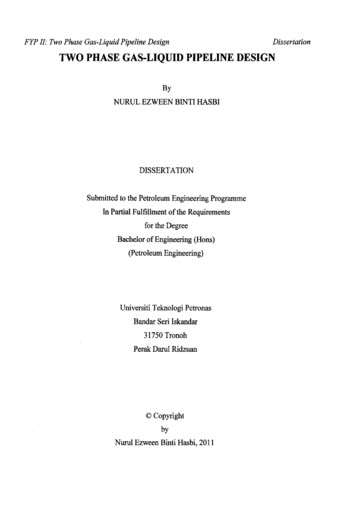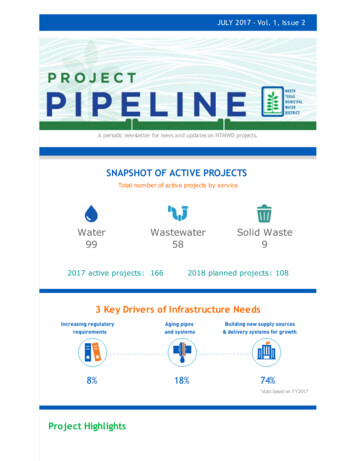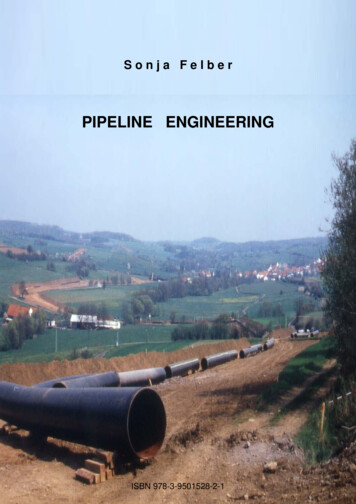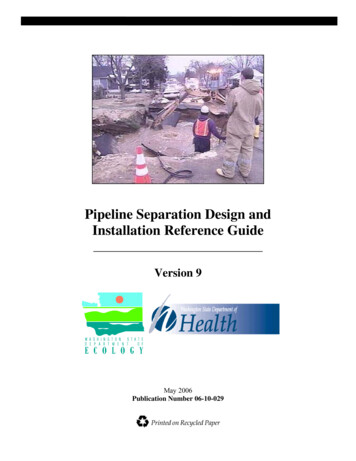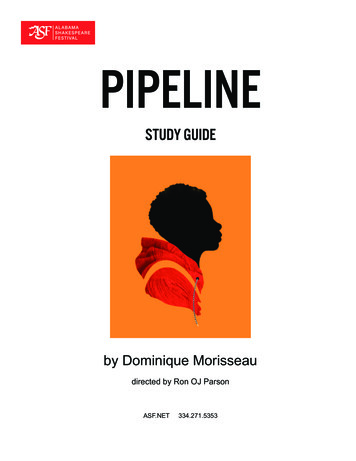
Transcription
PIPELINESTUDY GUIDEby Dominique Morisseaudirected by Ron OJ ParsonASF.NET334.271.5353
TABLE OF CONTENTSStudy Guide by Betsy Anne HugginsDirector of Education and Community Engagementbhuggins@asf.netPlot, Characters, and Settingpg 3About Dominique Morisseaupg 4The School-to-Prison Pipelinepg 5Classroom Resourcespg 6COMMON CORE STATE STANDARDSCOMMON CORE STATE STANDARDS cont.CCSS.ELA-LITERACY.CCRA.W.1 Write arguments tosupport claims in an analysis of substantive topics or textsusing valid reasoning and relevant and sufficient evidence.CCSS.ELA-LITERACY.CCRA.RL.11-12.1-3 Analyze theimpact of the author’s choices regarding how to developand relate elements of a story or drama (e.g., where a storyis set, how the action is ordered, how the characters areintroduced and developed).CCSS.ELA-LITERACY.CCRA.W.2 Write informative/explanatory texts to examine and convey complex ideasand information clearly and accurately through theeffective selection, organization, and analysis of content.CCSS.ELA-LITERACY.CCRA.W.3 Write narratives todevelop real or imagined experiences or events usingeffective technique, well-chosen details andwell-structured event sequences.CCSS.ELA-LITERACY.CCRA.R.5 Analyze the structure oftexts, including how specific sentences, paragraphs, andlarger portions of the text (e.g., a section, chapter, scene,or stanza) relate to each other and the whole.CCSS.ELA-LITERACY.CCRA.RL.11-12.9 Demonstrateknowledge of twentieth- and twenty-first-centuryfoundational works of American literature, includinghow two or more texts from the same period treat similarthemes or topics.CCSS.ELA-LITERACY.CCRA.RI.11-12.4 Determine themeaning of words and phrases as they are used in a text,including figurative, connotative, and technical meanings;analyze how an author uses and refines the meaning of akey term or terms over the course of a text (e.g., howMadison defines faction in The Federalist No. 10).CCSS.ELA-LITERACY.CCRA.R.6 Assess how point ofview or purpose shapes the content and style of a text.CCSS.ELA-LITERACY.CCRA.R.7 Integrate and evaluatecontent presented in diverse media and formats, includingvisually and quantitatively, as well as in words.CCSS.ELA-LITERACY.CCRA.SL.2 Integrate andevaluate information presented in diverse media andformats, including visually, quantitatively, and orally.NATIONAL CORE ARTS STANDARDSTH.Re7.1 Perceive and analyze artistic work.TH.Re8.1 Interpret intent and meaning in artistic work.TH.Re9.1 Apply criteria to evaluate artistic work.TH.Cn10.1 Synthesize and relate knowledge and personalexperiences to make art.TH.Cn11.1 Relate artistic ideas and works with societal,cultural and historical context to deepen understanding.ASF wishes to thank the Education department at Indiana Repertory Theatre, who allowedus to reprint “The School-To-Prison Pipeline” by Richard J. Roberts, Resident Dramaturg.2 ASF.NET
PLOT, CHARACTERS, AND SETTINGPLOTNya, an inner-city public high school teacher, is committed to her students but desperate to give her only son Omariopportunities her students will never have. When a controversial incident at Omari’s private boarding school may causehim to be expelled, Nya must confront his rage as well as her own choices as a parent. Will she be able to reach himbefore a world beyond her control pulls him away?CHARACTERSDominique Morisseau provided the below descriptions of the characters in her play.Nya: Black woman, mid-late 30s. Single mother. Public high school teacher. Trying to raise her teenage son on herown with much difficulty. A good teacher inspiring her students in a stressed environment. A struggling parentdoing her damndest. Strong but burning out. Smoker. Sometimes drinker. Holding together by a thread.Omari: Black man, late teens. Nya’s son. Smart and astute. Rage without release. Tender and honest at his core.Something profoundly sensitive amidst the anger. Wrestling with his identity between private school educationand being from a so-called urban community.Jasmine: Black or Latina woman, late teens. Sensitive and tough. A sharp bite, a soft smile. Profoundly aware of herselfand her environment. Attends upstate private school but from a so-called urban environment. In touch with thepoetry of her own language.Xavier: Black man, mid-late 30s. Nya’s ex-husband. Omari’s father. Single father. Struggling to connect to his own son.Marketing executive. Wounded relationship with his ex-wife. Financially stable. Emotionally impoverished.Laurie: White woman, 50s. Pistol of a woman. Teaches in public high school and can hold her own against the toughstudents and the stressed environment. Doesn’t bite her tongue.Dun: Black man, early mid-30s. Public high school security guard. Fit and optimistic. Charismatic with women.Genuine and thoughtful and trying to be a gentleman in a stressed environment. It’s not easy.SETTINGDominique Morisseau wrote the following about the setting of her play.Not necessarily New York City, but definitely modeled after it. Can be any inner city environment where the public schoolsystem is under duress. Present day.Also, we have undefined space. This is a place where location doesn’t matter. It is sometimes an alternate reality bleedinginto reality. It is sometimes just isolated reality that doesn’t require a setting. Only words.ASF.NET 3
ABOUT THE ARTISTSABOUT DOMINIQUE MORISSEAUDominique Morisseau is the author of The Detroit Project (A 3-Play Cycle)which includes the following plays: Skeleton Crew (Atlantic TheaterCompany), Paradise Blue (Signature Theatre), and Detroit ’67(Public Theater, Classical Theatre of Harlem and NBT). Additional playsinclude: Pipeline (Lincoln Center Theatre), Sunset Baby (LAByrinthTheatre); Blood at the Root (National Black Theatre) and Follow Me ToNellie’s (Premiere Stages). She is also the TONY nominated book writer onthe new Broadway musical Ain’t Too Proud – The Life and Times of theTemptations (Imperial Theatre). Dominique is alumna of The Public TheaterEmerging Writer’s Group, Women’s Project Lab, and Lark PlaywrightsWorkshop and has developed work at Sundance Lab, Williamstown TheatreFestival, and Eugene O’Neil Playwrights Conference. She most recentlyserved as Co-Producer on the Showtime series “Shameless” (3 seasons).Additional awards include: Spirit of Detroit Award, PoNY Fellowship,Sky-Cooper Prize, TEER Trailblazer Award, Steinberg Playwright Award,Audelco Awards, NBFT August Wilson Playwriting Award, Edward M.Kennedy Prize for Drama, OBIE Award (2), Ford Foundation Art of ChangeFellowship, Variety’s Women of Impact for 2017-18, and a recent MacArthurGenius Grant Fellow.Playwright Dominique MorisseauPLAYWRIGHT’S RULES OF ENGAGEMENT You are allowed to laugh audibly. You are allowed to have audible moments of reaction and response. My work requires a few “um hmms” and “uhn uhnns” should you need to use them. Just maybe in moderation.Only when you really need to vocalize. This can be church for some of us, and testifying is allowed. This is also live theatre and the actors need you to engage with them, not distract them or thwart their performance. Please be an audience member that joins with others and allows a bit of breathing room. Exhale together.Laugh together. Say “amen” should you need to. This is community. Let’s go.— Dominique Morisseau4 ASF.NET
THE SCHOOL-TO-PRISON PIPELINECredit: RidofranzOver the past 20 years, the term “school to-prisonpipeline” has been used to describe how harshschool disciplinary policies and law enforcementpolicies work together to feed young people intothe criminal punishment system. Researchershave found that excessive suspensions andexpulsions lead to various negative outcomes forstudents, including dropping out of school—andstudies have shown that high school dropoutsare more likely to be incarcerated than those whograduate high school. In particular, black studentsare disproportionately disciplined in school—although statistics show that they do not actuallymisbehave more than their peers.This trend can be traced back to the Columbineschool shootings in 1999. Since then federal andstate laws have instituted zero-tolerance policiesthat assign “explicit, predetermined punishmentsto specific violations of school rules, regardlessof the situation or context of the behavior.” At thesame time, in the streets, the war on drugs hasled to more punitive criminal legal responses,such as three strikes and mandatory minimumsentencing.than counselors. Many schools also have metaldetectors and surveillance cameras under thepretext of keeping students safe. The presence ofpolice officers in schools often leads to harsher,sometimes brutal treatment of students. Accordingto a 2011 report from the Justice Policy Institute,“when schools have law enforcement on site,students are more likely to be arrested by policeinstead of discipline being handled by schoolofficials. This leads to more kids being funneledinto the juvenile justice system, which is bothexpensive and associated with a host of negativeimpacts on youth.”The realization that zero-tolerance policiesin schools have led to criminalization andincarceration for students of color, and especiallyblack students, has prompted calls for restorativejustice and other, less punitive discipline practices.Some advocates say that the best way to preventfuture incarceration is to invest on the front end inproviding excellent educational opportunities forall. The outlook for such investment, however, isbleak. Nationally, since 1990, spending on prisonshas increased three times as quickly as spendingon education.Police officers in schools play a critical role inthis pipeline. In 1975, only one percent of U.S.schools reported having police officers; today,most urban schools have police on site. In NewYork City, public schools employ more copsThis article was written by Richard J. Roberts, Resident Dramaturg atIndiana Repertory Theatre, and published in IRT’s Pipeline study guide.ASF.NET 5
CLASSROOM RESOURCESDISCUSSION QUESTIONSPRE-SHOW QUESTIONS1. The American Civil Liberties Union defines the School-to-Prison Pipeline as “national trend wherein children arefunneled out of public schools and into the juvenile and criminal justice systems.” In the pipeline, students who commitin-school infractions are diverted out of schools and into jails, often because of zero-tolerance school policies.Have you seen the effects of the pipeline in your school and community? How do you think America’s schools cancombat this pipeline?2. Dominique Morisseau wrote a list of audience expectations she calls the Playwright’s Rules of Engagement (on pagefour of this guide). This list may be very different from typical rules you’ve experienced during live performance.Specifically, Morisseau encourages her audience to react verbally to the performance. Why do you think Morisseauwrote this list, and what does it say about her work as a playwright that she felt it necessary to create this list?POST-SHOW QUESTIONS1. The end of Pipeline does not provide a clear picture of what happens toOmari and his mother. What do you think happens after the play ends?2. Omari writes a list of ways his mother can support him. He includes the following:One: Hear me out.Six: Don’t assume me for the worst.Two: Let me chill sometimes.Seven: Show up. In person.Three: Know when to back off.Eight: Be fair.Four: Know when to keep pushing.Nine: Forgive that I’m not perfect.Five: Let me have some space.Ten:He omits the tenth instruction. What do you think Omari should add, and why?How can your parents, teachers, and friends support you?Cledie Taylor’s design of “We Real Cool” byGwendolyn Brooks, first printed by Detroit’sBroadside Press in 1966.CLASSROOM ACTIVITIES1. At Your Desk: Nya teaches Gwendolyn Brooks’ poem “We Real Cool” in Pipeline. Read and evaluate the poem andcompare the themes, language, and style to Pipeline. What does each work of art say about the African-Americanexperience in America? Have things changed? Write a third piece (either a poem or short story) that illuminatesyour perspective.2. On Your Feet: Did your experience at Pipeline change your perspective or deepen your understanding of theSchool-to-Prison Pipeline in America? In groups, create a Public Service Announcement (PSA) to educate your peersabout the issue. Research facts about the pipeline and take a strong stance. Write a script and act out the PSA(or even film it!). What action do you hope your peers will take to combat the pipeline? Are you encouraging positivepersonal choices, or institutional change?6 ASF.NET
This trend can be traced back to the Columbine school shootings in 1999. Since then federal and state laws have instituted zero-tolerance policies that assign "explicit, predetermined punishments to speciic violations of school rules, regardless of the situation or context of the behavior." At the same time, in the streets, the war on drugs has

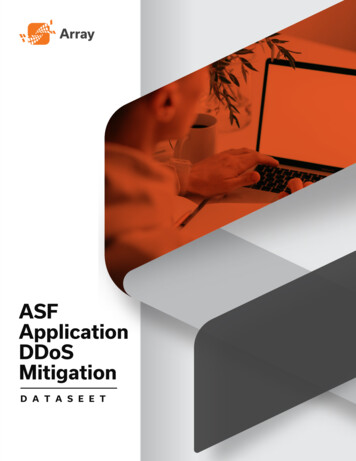
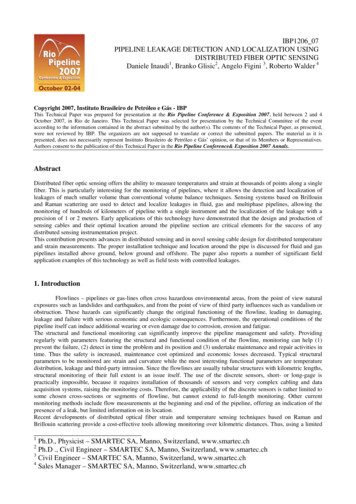
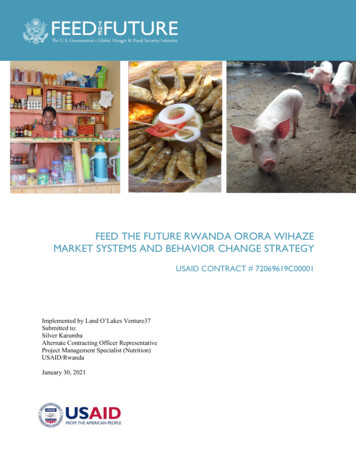
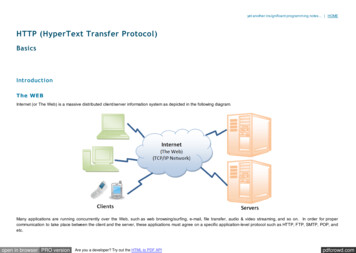

![4535&(* '3.&803, '03 %&.* 41 & ] - University of Virginia](/img/39/uvaacademicspaceframeworkplan.jpg)
